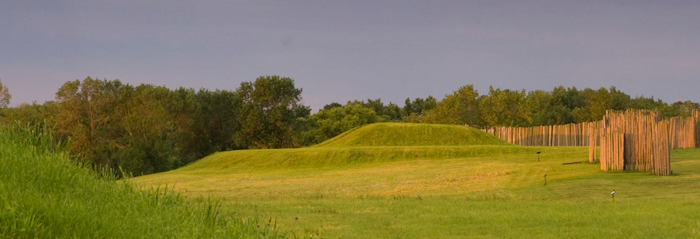Archaeological sites
Hundreds of recorded prehistoric and historic archaeological sites are located on DNR lands, while others are submerged beneath the surface of our lakes and rivers.
Prehistoric Native American burial and other mounds
Although Native Americans had been burying their dead for thousands of years, beginning in what archaeologists call the Woodland Period (ca. 500 B.C. to A. D. 1100), they began to bury their dead in earthen mounds of varying shapes. While most burial mounds are round or "conical" in shape, others are more linear, still others - effigy mounds - were built in the form of birds, bears, lizards, panthers and other forms.
Wisconsin has the highest concentration of prehistoric mounds in the country, and is the epicenter for effigy mounds (very few exist outside of the state). Additionally, ceremonial flat-top or "pyramidal" mounds and non-burial conical mounds were built very late in prehistoric times. Many mounds, including effigy mounds, are located in DNR's parks, forests and other properties, and previously unknown mounds are being discovered regularly. In Wisconsin, all prehistoric Native American mounds are protected as burial mounds.
Prehistoric rock art
Prehistoric rock art was produced by carving or painting images on rock surfaces. Carved images are called petroglyphs, while painted images are called pictographs. Most rock art sites are found on easily carved sandstone outcrops in the southwestern part of the state, with relatively few sites found in other areas. Images include people, "thunderbirds", deer, birds and other forms. Very few identified rock art sites occur on DNR property.
Prehistoric and early historic Native American camp, village and related sites
Given the extensive areas of the state that DNR manages, it is no surprise that many prehistoric archaeological sites occur on DNR lands (as well as beneath its waterways, in some cases). Most of these sites are not readily apparent to the casual visitor, for they typically lie beneath the grasses and forest cover of DNR properties. However, several of these sites, including Aztalan National Historic Landmark (a state park), are well-recognized and well-visited, providing a glimpse into the lifeways of the Native Americans who first settled in the region, creating towns, growing crops and raising families.
CCC camps and historic logging camps
The harvesting of timber was an important engine of the state's early economic development, just as it is today, and camps to support logging operations were built throughout much of Wisconsin. Depression-era Civilian Conservation Corps (CCC) camps, were built to provide support for the numerous CCC projects undertaken in the state, including many projects within current DNR parks and forests. Remnants of these camps, including berms and pits associated with mess halls, dormitories and other features, are still evident - if you look for them. A number of remnant CCC and logging-era camps are present on DNR properties.


